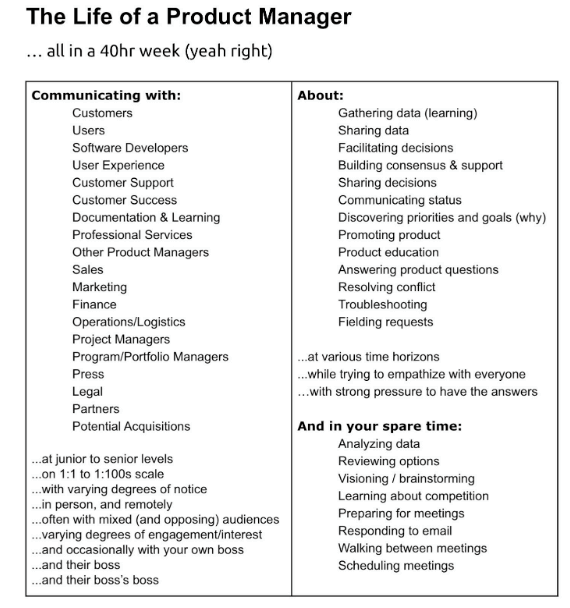John Cutler, one of the product people I most admire, recently tweeted the below image with the note, “The job is like 90% communication.”

John’s absolutely right — the job is 90% communication. In fact, everything a PM does ties back to their ability to communicate effectively. Product managers need to build a strong team, inform stakeholders of progress, translate roadmaps for the rest of the org, and manage their day-to-day tasks — all of which require strong communication skills.
The way I’ve begun to think about communication as a product manager is to keep a steady cadence, be concise, build community, and catalog what matters. This conveniently gives us the “4 Cs of Product Communication.”
Let’s go through each one in more detail.
1. Cadence
The first and most important thing about communication is establishing a concrete cadence. Often, we fall into the trap of saying things like, “I’ll send out a stakeholder email periodically” or even, “I’ll send monthly update decks.” Inevitably, fluffy deadlines get pushed back. In fact, most loosely scheduled communications never even happen. Instead, drive communication cadence by creating “uncomfortably specific” deadlines, such as, “I send out X email on the last business day of each month.”
This fixed cadence does two things. The first is that it holds you to a deadline. For the last 16 months, I’ve been sending out a six-bullet-point recap email to all stakeholders on our product team on “the last business day of each month.” I’ve never missed an update. Why? Because I set a firm deadline for myself, one I can see right on my calendar.
Second, by setting a fixed cadence, you set an expectation with stakeholders about when they can expect updates. These people, who care about your product, team, or mission, will come to expect these updates regularly. Some may even add time on their own calendars for consuming these messages.
2. Concise
While having a concrete cadence only applies to scheduled communication, the idea of being concise can and should hold true for every type of communication a PM does. Being concise sharpens your message. It forces you to lead with impact, focusing on your most important message above all else.
Keep it high level. If people want details, they’ll ask.
Being concise also increases the likelihood that people will actually consume your message. In today’s world, we’re all too busy to consume every piece of content sent our way. This is what makes Twitter so successful — it offers heaps of brief, valuable information.
How can you accomplish this brevity? For starters, anytime you’re about to communicate something, written or oral, delete 10% of it. Then, do that again. Basic sentences are best. To take this a step further, use bullet points where possible. Complete sentences are mostly unnecessary. All of this is easy to do in written communication when you have the luxury of time. But being concise in oral communication takes deliberate, daily practice. When you need to communicate with hundreds of teams, a concise message can help get your point across to the entire audience.
For the purpose of this post, I went back and analyzed the monthly emails I mentioned earlier. The average word count was 325 and the max (busy month) was 441 words. I still think this is a bit long-winded, but it’s in line with the amount of time my audience has to read these messages.
3. Community
A cross-functional “comms community” can amplify your communications and share messages across departmental lines. When it comes to communicating updates, PMs tend to message only the direct stakeholders, who are usually on or closely aligned with an existing team. This creates a kind of communication echo chamber. People who are already in the loop hear and see the same things repeatedly. As a result, they tune out and mostly disregard the communications they receive.
However, a cross-functional community does the opposite. Such a community might include stakeholders from marketing, legal, sales, services, and various product teams. When the entire group shares your communications, your message reaches across the organization and finds a broader audience. If this is done right, people will be coming up to you in the halls asking you about that upcoming feature before you’ve even told them about it.
4. Catalog
Make sure all comms are archived and accessible! At a rapidly-growing organization, team members are constantly moving around. When this happens, it can take weeks or sometimes months for new team members to get up to speed on a team’s mission, history, and goals.
However, if all formal communications are appropriately cataloged by time and topic, you’ll have an evergreen onboarding resource at your fingertips. Give this to new members of your team on their first day and make it required reading. Once they’ve completed it, you’ll be amazed at how quickly they can start making an impact, even referencing the history of a product they weren’t a part of. Ideally, you’ll never hear, “This was before my time” again.
Well-cataloged communications can also help PMs point to their successes. For example, when sitting down for a quarterly review, you can reference each of the things you’ve communicated up until that point. You’ll be able to quickly and easily demonstrate your impact on the organization.
Finally, cataloging these comms can be a great way to analyze your own performance. Were you wildly off on a timeline estimation? Did you commit to a goal and never complete it? At a fast-moving org, it can be easy to forget these missteps and simply move on. However, if you periodically review the things you’ve committed to or communicated publicly, you will be able to reference where you were wrong and right and adjust in the future.
Communication is at the root of almost every single PM role. If you’re doing it well, many other aspects of your job around you will fall into place as well. By using the framework of the 4 Cs, you’ll become a more effective communicator. And at the end of the day, your customers will thank you!


